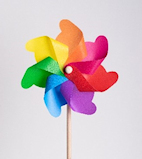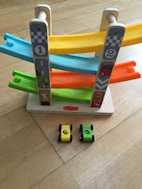My Pre-verbal Child - Building Foundation Skills
Here are some ideas of how you can help your child build the foundation skills for communication.
Understanding what is about to happen
 Use objects of reference or photographs to help your child understand what is about to happen. An object of reference in an object that is consistently used to represent an activity or place or person, eg showing your child the spoon to let them know it is time for lunch.
Use objects of reference or photographs to help your child understand what is about to happen. An object of reference in an object that is consistently used to represent an activity or place or person, eg showing your child the spoon to let them know it is time for lunch.Understanding cause and effect

This is the understanding that our actions have an effect. Cause and effect toys include toys that make a noise, light up or move when you press a button or touch something.
Build excitement with your voice and facial expressions. Try making the play into a Ready Steady….GO game. Gradually leave a slightly longer gap between ‘steady’ and ‘GO!’ to create excitement. See if your child starts to show some anticipation. They might look at you or at the toy or they might make a sound or even try and say ‘GO’ themselves.

Turn-taking and back-and-forth interactions
Conversation is a back-and-forth activity. Help your child to start learning about back-and-forth by playing games together which involve taking turns. Take turns to:
- roll a ball to each other
- put a brick onto a tower
- press a button on a pop-up toy
- place a marble on a marble run or a car onto a car track
While you are doing this, model the language that goes with this back-and-forth play, such as “my turn” and “your turn”.
Try other People Games (back and forth games with your child) such as:
- Peek-a-boo
- Ready steady….tickles
- Songs with actions you can do together, eg Row Row Row your Boat. When your child has become familiar with the song, leave pauses and wait for them to fill in the gap – they may respond to the pause by using words, looking at you or smiling to request more of the song!
Attention and listening
Attention and listening are core skills for developing speech, language and communication. At first, you may see your child startle if they hear a loud or sudden noise. Their focus may be quite fleeting and they may be easily distracted by other things they can see or hear. Gradually, children learn to keep their focus for a bit longer on something they find interesting. Try these activities to help develop early Attention and Listening skills:

Bubbles:
Call your child’s name and wait for them to look at you before blowing bubbles. Have fun watching the bubbles together. You can practice clapping, popping and stamping on the bubbles. Label the actions as you play e.g. “pop, pop, pop” or “clap, clap, clap”.
Parachute:
Try and find a small and colourful scarf or shawl at home. Encourage your child to hold on to one side of the shawl/scarf. Have fun moving it up and down. Wait for your child to look at you before shaking the shawl/scarf from side to side. Try a song with the activity “Here we go up, up, up…here we go down, down, down,…here we go up, up, up and …pause…. shake it all around!
Musical Instruments:
Have fun tapping on pots or pans with your child at home. You can also fill small tubs with dry rice or lentils and have a go at shaking them! Turn this into a stop/go game by saying “stop” and waiting for your child to look at you before saying “go!” and continuing to tap or shake the homemade instruments!Nappy Changes:
You can use the opportunity of nappy changes for encouraging interaction and play with your child. You could use the opportunity to sing a nursery rhyme for them; watch and respond to the sounds or faces your child makes or make some of your own and see if they copy you. They love to watch you!
Quiet Time
Not every moment needs to be filled. Quiet time is just as important. Sometimes young children need quiet time to listen to their own voices and consolidate what they have experienced. There are lots of sounds, noises, smells, activities and learning that take place all throughout the day. Young children may show signs that they need some quiet time – they may look away, cry or wriggle their arms or legs.
Last updated10 Sep 2025

